Karnataka 2nd PUC Biology Notes Chapter 5 Principles of Inheritance and Variation
→ Genetics is a branch of biology which deals with the study of heredity and variations. The term genetics was coined by Bateson.
→ Heredity is the process of transmission of characters from parents to offsprings. Variations means the morphological differences among the individuals of the same species or offsprings of the same parents.
→ The foundation of the growth of such an attractive branch genetics is done by the contribution of Mendel in the form of laws of heredity which hold good even today with respect to ‘The Principles’s governing the inheritance of characters”. So Mendel is rightly regarded as “The Father of Genetics”.
![]()
Terminology:
→ Gene – It is a specific segment of DNA having a definite number of nucleotides which code for a particular protein.
→ Locus – The place or position of a gene or its allele on the chromosome is called locus.
→ Genetic code – It is the genetic dictionary universally. Employed by all organisms to convert the language of gene into the language of protein.
→ Alleles or Allelomorphs – The alternative forms of agene that occupy the same position on the homologous chromosome are called alleles or allelomorphs.
→ Homozygous – It is a situation of an individual in which a particular character is controlled by a pair of similar genes.
→ Heterozygous – It is a situation of an individual in which a particular character is controlled by a pair of dissimilar genes.
→ Hemizygous – It is a situation where a character is controlled by one gene, and its allele is being absent, e.g.: Sex-linked characters in human males
→ Homologous chromosomes – The chromosomes that are exactly similar with regard to their size, shape, number and arrangement of genes.
→ Heterologous chromosomes – The chromosomes that are dissimilar with regard to their size, shape number and arrangement of genes.
→ Hybrid – It is an offspring obtained by.crossing two parents which differ from each other, at- least in one pair of contrasting characters.
→ Monohybrid cross – It is a cross in which the pattern of inheritance of only one character is followed.
→ Dihybrid cross – It is a cross in which the pattern of inheritance of two characters is followed.
→ Dominant gene – A gene which has the capacity to express in the hybrid condition.
→ Recessive gene – A gene which fails to express in the hybrid due to presence of a dominant gene
→ Phenotype – The external, appearance of an individual which has resulted, due to the interaction between the genotype and the environment.
→ Genotype – The total genetic constitution both expressed and suppressed of an organism is said to be its genotype.
→ FL generation – It is the first filial generation obtained by crossing two parents.
→ F2 generation – It is the second filial generation obtained by selfing F1
→ Gamete – It is a haploid sex cell produced from a diploid parent.
→ Reciprocal cross – It is a cross in which the parents are reversed with respect to their sex with reference to the previous cross.
→ Test cross – It is a cross made between the Organism of unknown genotype with double recessive individual to determine the nature of the unknown genotype (ie., homozygous/heterozygous)
→ Back cross – It is a cross made between F1 hybrid back with any of the parents.
![]()
Mendel and his Work::
Mendel’s work: Mendel conducted a series of hybridization experiments on pea plants and the pea plants are the right materials for hybridization experiments, because they are annuals and can be easily maintained. They show different types of variations and also cross pollination can be easily avoided in the flowers. He recognised 7 pairs of contrasting characters in pea plants. They are as follows:

Mendel conducted both monohybrid and dihybrid crosses by selecting one pair of contrasting characters initially, and then two pairs of contrasting characters in the parents.
Monohybrid Cross: Mendel selected two plants. One with tall and the other with dwarf to get F, generation. To his surprise, he got all tall plants in the F1 generation.
Parents: Tall plant × Dwarf plant
F1: → All tall plants.
Thus the tall character appeared in the F1 generation but dwarf character did not appear. He self crossed the F1 plants and raised the F2 generation. Surprisingly he got both tall and dwarf plants in the ratio of 3:1 respectively. This ratio is called Phenotypic ratio. He repeated the experiment by taking other contrasting characters and got the same results.
F1 → Tall plant × F, Tall plant
F2 → Tall plants : Dwarf plants
3 : 1
Based on these results, he concluded that the tall character is dominant and the dwarf character is recessive. Then he used appropriate symbols to designate the dominant and recessive factors. He used capital letters for dominant factors and small letters of the same type to denote the recessive alleles. The monohybrid cross can be represented as below.
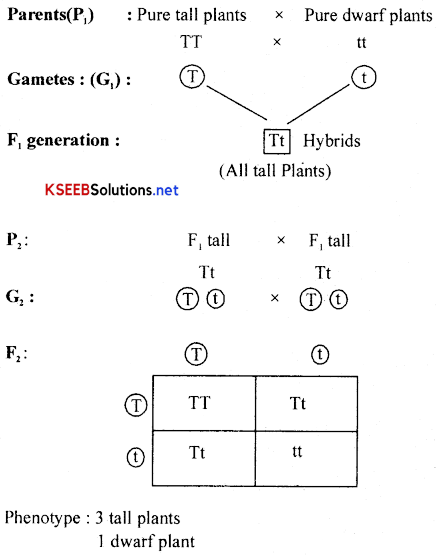
![]()
Number of plants of alleles
involved – 1 pair
Base Number – 4
Phenotypic ratio – 3 : 1 (3 tall: 1 dwarf)
Genotypic ratio – 1 : 2 : 1
Phenotypic classes – Two (Tall and dwarf only)
Genotypic classes – Three
[1-homozygous tall, 2-heterozygous tall and 3- homozygous dwarf]
Based on these results, he formulated the first law of heredity called the Law of Segregation or Law of Purity of gametes. It states that, “Whenever a pair of alleles are brought together in a hybrid union, they remain together without mixing and they get separated when the hybrid forms gametes”.
In addition to this law, two other laws are also formulated based on the monohybrid cross. They are:
(a) Law of unit character
(b) Law of dominance
(a) Law of unit character: According to this law each plant is a bundle of characters that are inherited from generation to generation. Thus, these characters are units by themselves. Each character is controlled by two genes or a pair of alleles.
(b) Law of dominance: According to this law, when two parents differing in one pair of contrasting, characters are crossed, only one character is expressed in F1 generation and the other is suppressed. The character expressed in the F1 generation is due to the dominant gene and the phenomenon is called dominance. The character that is not expressed is called recessive character and the gene responsible is the recessive gene.
Back cross and Test cross: A cross made between F1 hybrids back with any one of the parents from which they were derived is called back cross.
When F1 hybrid is crossed with the dominant parent, no individuals with recessive character are obtained in the progeny. On the other hand, when F1 hybrid is crossed with recessive parent, both dominant and recessive characters appear in the progeny: Thus the F1 hybrid is heterozygous. Crossing the F1 individual with recessive parent is known as Test cross, because it is used to test whether the F1 or any given plant is homozygous or heterozygous for a particular character, and also to test the validity of Mendel’s laws of heredity.
For example, if the given plant is homozygous for a character concerned, we do not get individuals with recessive characters. Instead, we get only the dominant characters.
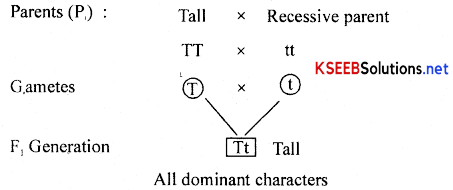
If the given plant is heterozygous for a character concerned we get both recessive and dominant characters in the ratio of 1 : 1
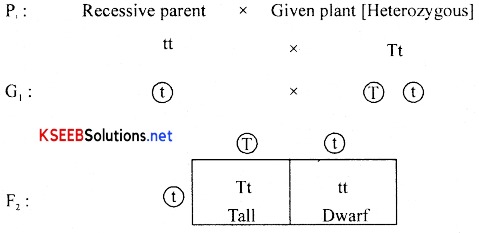
The phenotypic and genotypic ratio = 1 : 1 So, based on this result, we can say that the genotype of a given plant as heterozygous Further the genes are separated during gamete formation, and thus dominant and recessive characters appear in the progeny.
Test cross method can also be applied to dihybrid cross to test the validity of Mendel’s second law, i.e., Law of Independent Assortment.
![]()
Incomplete Dominance or Blending Inheritance:
→ The concept of dominance’ by Mendel is not universal, because several cases have indicated that dominance is incomplete. It is a deviation from Mendel’s work. In these cases it is found that in the F1 hybrid, neither of the parental characters were completely expressed Instead, a new intermediate character is expressed in F1 generation Hence it is said to be ‘Incomplete dominance’. This situation has been reported both in plants and animals.
→ In Mirabilis or 4° clock plant, incomplete dominance has been reported with respect to colour of the flower. In these plants when a plant producing red flowers is crossed with a plant producing white flowers, some produce red flowers and some others produce white flowers. In the F, generation all plants produced pink flowers. It is a heterozygous condition the pink character is an intermediate or a blend between red and white. This colour is produced because the red is being partially dominant over white. ‘
P1Red flowers × White flowers
F1 Pink flower
→ When F1 pink flower plants are self crossed to raise F2 progeny 3 types of plants are produced e, Red, Pink and White, in the ratio of 1 : 2 : 1 respectively.
→ By using appropriate symbols, the incomplete dominance can be represented as shown below.
→ This cross is illustrated as indicated below by using appropriate letters.
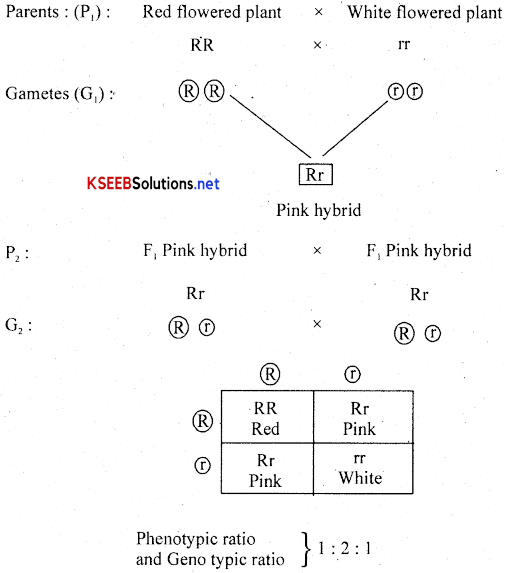
→Thus in this case parental characters are expressed in homozygous condition, and intermediate character in heterozygous condition.
→ Another example for incomplete dominance is seen in snapdragon plants In this plant, incomplete dominance is reported with respect to colour of the flower and shape of the leaves. Some plants produce Red flowers and Broad leaves and some others produce white flowers and Narrow leaves. When a plant with Red flowers and Broad leaves is crossed with a plant with a plant with white flowers and narrow leaves in the F1 generation all plants produce pink flowers with slightly narrow leaves.
![]()
Co-Dominance:
It is a phenomena where both the alleles in a heterozygous condition express themselves equally.
- The blood group in humans is controlled by a single gene (IA) with three alleles, IA, IB and i
- The gene IA and IB are dominant over the recessive allele i, whereas the allele IA and IB are co-dominant i.e. they are expressed together without being influenced by each other.
- Genetically, a person having blood group ‘A’ may be homozygous(IA IA) or heterozygous (IAi)
- A person having blood group ‘B’ will be homozygous (IBIB) or heterozygous (IBi)
- A person having blood group ‘AB’ will be (IA, IB), heterozygous co-dominant.
- A person having blood group ‘O’ will be (ii), homozygous recessive.
| Blood group | Genotypes |
| A | IAIA – Homozygous |
| IAi – Heterozygous | |
| B | IBIA – Homozygous |
| IBi – Heterozygous | |
| AB | IA IB – Codominant |
| O | IA IB – Homozygous recessive |
Usually a gene exists in two alternative forms, but some time a gene may exist in more than two alternative forms. This phenomenon of a gene occurring in multiple forms for a character located on the same locus in different organisms is called multiple allelism or Gene polymorphism. A,B, AB, O blood groups are the best examples of multiple allelism.
![]()
Pleiotropy:
→ In this phenomenon, a single gene product may produce more than one phenotypic effect.
→ Even in garden peas,such aphenomenon has been observed in the following characters :
- Starch synthesis / size of starch grains and the shape of seeds are controlled by one gene.
- Flower colour and seed coat colour are found to be controlled by the same gene.
→ Starch is synthesised effectively by the homozygotes, BB and hence the starch grains are large and the seeds at maturity are round.
→ The homozygotes, bb are less efficient in starch synthesis; hence they have small starch. grains and the seeds are wrinkled.
→ The heterozygotes, Bb produce round seeds, indicating the B is the dominant allele, but the starch grains are intermediate in size and hence for the starch grain size, the alleles show incomplete dominance.
→ It is an example of pleiotropy as the same gene controls two traits, i.e., seed shape and size of starch grains.
→ The genotypes and the phenotypes for the two traits are as follows:
- BB – Round seeds, large starch grains.
- Bb – Round seeds, intermediate sized starch grains
- bb – Wrinkled seeds, small starch grains.
→ Here, it can also be meritjpned that dominance is not an autonomous feature of the gene or its product, but it depends on the production of a particular phenotype from the gene product.
![]()
Dihybrid Cross:
→ In a dihybrid cross, Mendel selected two pairs of contrasting characters. He selected the shape and colour of the seed as two characters, for his cross. He recognised round and wrinkled shape of the seeds as one pair of contrasting characters and yellow and green colour as another pair of contrasting characters.
→ He crossed a plant having Yellow and Round seeds with a plant having Green and Wrinkled seeds and got F1 generation. In the F1 he got all the plants producing Round and Yellow seeds. Thus he found that, yellow and round traits were dominant over green and wrinkled, respectively.
→ Later, he self-crossed the F1 hybrids and raised F2 generation. In this generation, he got four types of plants producing Yellow-Round, seed Yellow-Wrinkled seed, Green Round seed, and Green- Wrinkled seed. Thus he got two new characters-Yellow-Wrinkled seed and Green Round seed, in addition to the parental characters.
→ By using appropriate letters to denote dominant and recessive genes, the dihybrid cross is represented as shown below:

→ Thus in the F2 generation, he got Yellow Round, Yellow wrinkled, Green round and Green wrinkled in the ration of 9 : 3 : 3 : 1, respectively.
Number of pairs of alleles
involved = two pairs
Base Number = 16
Phenotypic ratio = 9 : 3 : 3 : 1,
Genotypic ratio = 4 : 2 : 2 : 2 : 1 : 1 : 1 : 1.
Phenotypic classes = Four (Yellow Round, Yellow Wrinkled, Green Round, Green Wrinkled)
Genotypic classes = 09
→ Based on the results of dihybrid cross, he came to the conclusion that the four genes for two pairs of contrasting characters are separated independently in the F1 hybrids because the genes were present on different chromosomes and combined in the F2 generation to produce four characters.
→ Based on the results of the dihybrid cross, he formulated the second law of heredity namely, the Law of Independent Assortment. It states that “When genes or alleles for two or more separate pairs of contrasting characters are brought together in a hybrid, they separate independent of each other.
![]()
Rediscovery of Mendel’s Laws:
→ Though Mendel published his work and the laws of inheritance in 1865, they remained unrecognized till 1900, for the following reasons:
- His work could not be widely publicised as communication was not easy.
- His concept of ‘factors’ as stable and discrete units that controlled the expression of traits, and that of pair of alleles which did not blend with each other, were not accepted by his contemporaries as the explanation for variation.
- Mendel’s approach of using mathematics to explain the biological phenomena was new and unacceptable to many biologists.
- Though Mendel’s work suggested that factors were discrete units, he could not provide any physical proof for the existence of factors or prove what they are made of.
→ In 1900, de Vries, Correns and Tschermark independently rediscovered Mendel’s results on the inheritance of characters.
→ By then,,there had been advancements in microscopy and scientists were able to observe cell division, nucleus, chromosomes, etc.
→ By 1902, chromosome movements during cell division had been worked out.
Chromosomal Theory of Inheritance:
→ Walter Sutton and Theodor Boveri independently postulated this theory in 1902.
→ They found that the behaviour of chromosomes was parallel to the behaviour of mendelian factors (genes) and used the chromosome movements to explain Mendel’s Laws.
→ The similarities are as follows:
- Both genes and chromosomes occur in pairs in normal diploid cells.
- Both of them segregate during gamete formation and only one member of each pair enters a gamete.
- Members of each pair segregate independently of the members of the other pair(s).
→ Sutton and Boveri argued that the pairing and separation of the homologous pair of chromosomes would lead to the segregation of a pair of factors they carried.
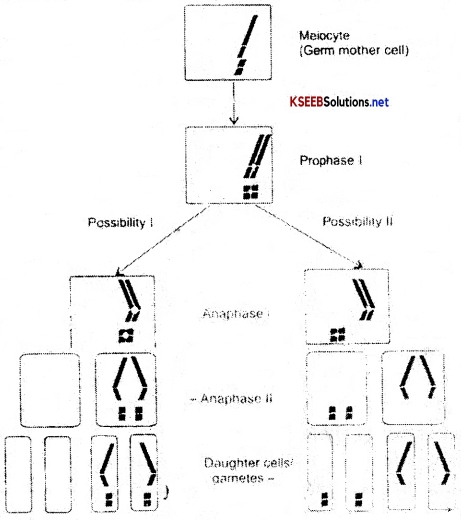
![]()
Thomas Hunt Morgan and Genetics:
→ T.H. Morgan worked on fruit flies (Drosophila melanogaster).
→ They are found suitable for studies in genetics for the following reasons
- They could be grown on simple synthetic medium in the laboratory.
- The flies complete their life cycle in about two weeks.
- They could produce a large number flies in the progeny of a single mating.
- The male and female flies are distinct and show many types of hereditary variations that could be easily observed
→ Morgan carried out many dihybrid crosses in Drosophila with the genes that were sex-linked, i.e. the genes are present on the X-chromosome.
→ He observed that the two genes under consideration in his experiments did not segregate independently as in the case of characters studied by Mendel.
Linkage and Recombination:
→ Morgan and others observed that when the two genes in a dihybrid cross are located on the same chromosome, the proportion of parental gene combinations in the progeny was much higher than the non-parental or combinations (also called recombination) of genes.
→ They also found that the proportion of recombinants varies, even if the two genes are present on the same chromosome.
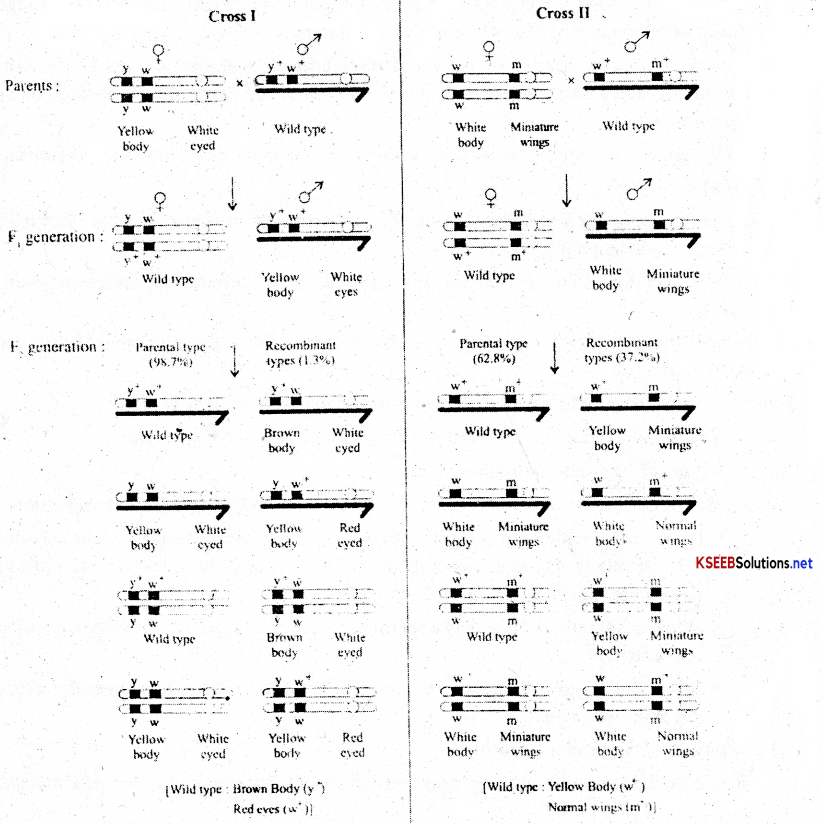
→ If the linkage is stronger between two genes (tightly linked), the frequency of recombination is low, and vice versa.
→ In an experiment with flies he hybridised yellow-bodied and white-eyed females with brown -bodied and red-eyed males (wild type) (Cross I) and intercrossed their F1 progeny.
![]()
→ The F2 generation contained the following:
The parental combinations were 98.7% and the recombinants were 1.3%.
→ In another cross (Cross II) between white-bodied female fly with miniature wing and a male fly with yellow-body and normal-wing, the progeny contained the following:
The parental combinations were 62.8%, while the recombinants were 37.2%.
→ It is evident that the linkage between genes for yellow-body and white-eyes is stronger than that between genes for white-body and miniature wings.
→ Sturtevant used the frequency of recombination between the gene pairs on the same chromosome as a measure of the distance of the genes and mapped their position on the chromosome.
→ Today genetic/chromosome maps are used in the sequencing of genomes of organisms.
Sex-Determination:
→ The concept of genetic/chromosomal basis of sex-determination came from the cytological observations made in a number of insects.
→ H. Henking (1891) could trace a specific nuclear structure all through spermatogenesis in a few insects.
→ He observed that 50% of the sperms received this structure, while the remaining 50% did not receive it.
→ Henking named the structure as X body, but could not explain its significance.
→ Later it was found to be a chromosome and it was named as X-chromosome.
(a) XO-type of Sex determination
- A large number of insects like grasshopper show XO type of sex determination.
- It is a case of male heterogamety, where 5 0% of the sperms bear an X-chromosome and the other 50% of the sperms do not have the X-chromosome, but only the autosomes; all the ova bear an X-chromosome.
- When an ovum is fertilised by a sperm having X-chromosome, the zygote develops into a female.
- When the ovum is fertilised by a sperm having no X-chromosome, the zygote develops into a male.
(b) XY-type of Sex determination
- In insects like Drosophila melanogaster and in human beings, this type of sex-determination is seen.
- The males have an X-chromosome and another small, but characteristically-shaped Y- chromosome, i.e., males have XY chromosomes along with other autosomes.
- The females have two X-chromosomes along with the other autosomes.
- It is a case of male heterogamety, where the males produce two types of sperms, 50% of sperms having one X-chromosome and the other 50% with one Y-chromo some.
- The females arc homogametic and produce all ova with on e X-chromosome.
- Sex of an individual is decided at the time of fertilization by the type of sperm fertilizing the ovum.
It is as given below:

![]()
(c) Z-W type of sex-determination
- This type of sex determination is seen in certain birds.
- The females have ZW chromosomes along with the autosomes and the males have ZZ chromosomes.
- It is a case of female heterogamety, where the females produce two types of ova. 50% of ova with one Z-chromosome and the other 50% with one W-chromosome.
- The males are homogametic and produce sperms all, with one Z-chromosome.
- In this case, the sex of the individual is determined by the type of ovum that is fertilised to produce the offspring.
(d) Haplodiploid sex-determination
- This type of sex-determination is seen in honeybees; it is based on the number of set s of chromosomes, an individual receives.
- When the ovum is fertilised by a male gamete, the diploid the zygote (21/ = 32) develops into a female, i.e., a queen or worker.
- When the ovum develops by parthenogenesis, i.e., without fertilisation, a male individual, called drone, is formed.
- The male honeybee (drone) is haploid (with n = 16 chromosomes) and forms sperms by mitosis.
- The sex- determination is as follows
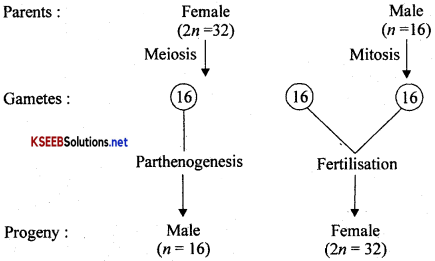
- The special characteristic features of this system of sex-determination are :
- the male honeybees denot have a father, but have a grand father.
- they donot have sons, but can have grandsons.
Mutations:
→ Mutations are of the following types:
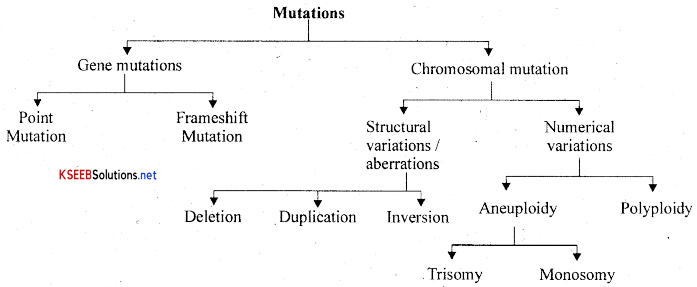
→ Gene mutations result in alteration in the sequences of bases of DNA or a change in the base and thereby change in the genotype and phenotype of an organism.
→ A mutation that involves a single base change is called point mutation; a classical example of point mutation is sickle-cell anaemia.
→ Deletion or insertion/duplication/addition of one or t\Vo bases in the DNA results in a change in the reading frame, thereby resulting in a polypeptide with a different set of amino acids.
→ Structural alternations of the chromosomes result due to loss or gain of large segment of DNA, as DNA / genes are located on the chromosomes.
→ When the members of a homologous pair of chromosomes fail to segregate during anaphase 1 of meiosis, aneuploidy results; there is loss or gain of one or more chromosomes.
→ Failure of separation of the duplicated chromosomes into daughter nuclei results in polyploidy a phenomenon in which the cell has three, four or more sets of chromosomes.
→ The physical and chemical agents /.factors that bring about mutations, are called mutagens.
→ Mutations are also responsible for variation.
![]()
Pedigree Analysis:
→ Inheritance pattern oftraits in human beings cannot be studied by crosses as in other organisms, for the following reasons:
- Controlled crosses cannot be performed.
- The progeny produced is very small (usually one) and takes a long time.
→ Pedigree analysis is the important tool to trace the inheritance of a specific trait, abnormality or disease to study human genetics.
→ In a pedigree Chart, conventionally the following symbols are used:
- Circles denote females
- Squares denote male
- Mating is shown by a horizontal line connecting a male symbol with a female symbol.
- Offspring symbols are arranged from left to right in the under of birth and connected by a horizontal lien below the parents, and this lien is connected to parent/ marriage lien by a vertical line.
- A solid/blackened symbol represent the individual with the trait being studied.
- An open or clear symbol represents the absence of the trait or abnormality under study.
- The offspring are connected to a horizontal line below the parents and the line is connected to the parental line by a vertical line.
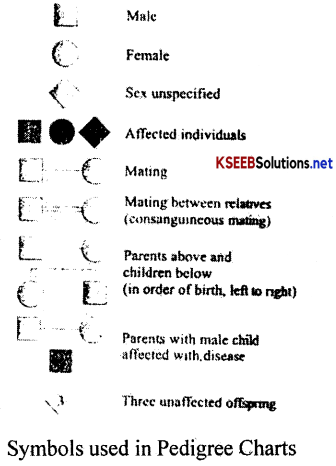
![]()
Genetic Disorders:
→ Genetic disorders can be grouped into two categories
(a) Mendelian disorders and,
(b) Chromosomal disorders
(a) Mendelian Disorders:
- These are mainly due to alternation or mutation in a single gene.
- These disorders may be dominant or recessive.
- The disorders are transmitted from one generation to the next following Mendel’s principles of heredity; these disorders maybe:
- (a) autosomal as in cystic fibrosis, sickle-cell anemia and phenylketonuria.
- (b) sex linked as in haemophilia, colour blindness and myotonic dystrophy.
- Some Mendelian disorders are discussed below:
(i) Haemophilia:
- It is a sex-linked, recessive disorder whose gene is present on the X-chromosome.
- The defective allele produces a defective protein, which is part of the cascade of proteins involved in the clotting of blood.
- Clotting of blood is abnormally delayed that even a simple / small cut will result in non-stop bleeding in the affected individual.
- More males than females suffer from the disorder as they have only one X-chromosome, and the recessive allele on it expressed.
- The possibility of a female becoming haemophilic is very rare, as she has to receive the defective alleles from both the parents and be homozygous recessive, i.e., her mother must atleast be a carrier and father haemophilic.
- Heterozygous female is a carrier and passes on the disease to some of her sons; Queen Victoria was a carrier of this disease and produced haemophilic descendents.
(ii) Colour blindnes:
- It is a sex-linked, recessive disorder with the mutant gene on the X-chromosome.
- The defect is in the red or green cones of the eye and the victim is unable to discriminate between red and green colours.
- It occurs in 8 percent of male and only 0.4 per cent females.
- Inheritance pattern is very similar to that of haemophilia, in that more males than females suffer from the disorder.
- A colour-blind female is rare, as her mother has to be atleast a carrier and father colour blind and she must be homozygous for the recessive defective allele.
- A heterozygous female has normal vision, but is a carrier and passes on the disorder to some of her children.
![]()
(iii) Cystic fibrosis:
- It is caused by a recessive mutant allele on an autosome (chromosome 7).
- The gene produces a unique glycoprotein that leads to the formation of mucus of abnormally high viscosity.
- This type of mucus interferes with the functioning of many exocrine glands like sweat glands, liver, pancreas and lungs.
(iv) Sickle-cell Anaemia:
- It is caused by a mutant recessive allele on chromosome 11.
- The mutant gene causes the substitution of glutamic acid (glu) by valine (val) at the sixth position of the beta globin chain of haemoglobin. This substitution of the amino acid is the result of a single base Substitution, in the sixth codon of the beta globin gene, from GAG to GUG
- The normal (Hb-A) and the defective (Hb-S) peptides are as follows:

- The defective haemoglobin undergoes polymerisation under low oxygen tension and changes the shape of RBC from biconcave cells to sickle-shaped elongated cells.
- The disease is controlled by a single pair of alleles, HB and Hb.
- Of the three possible genotypes, only individuals homozygous for Hb(Hb Hb) show the disease, though heterozygous individuals (Hb Hb) are carriers.
- When both the parents are heterozygous /carrier for the gene, the disease appears in some of their children.
(v) Phenylketonuria.
- It is caused by a recessive mutant allele on chromosome 12.
- The affected individuals lack an enzyme that catalyses the conversion of the amino acid phenylalanine into tyrosine.
- Consequently phenylalanine is metabolised into phenyl pyruvate and other derivatives.
- Accumulation of these chemicals in the brain results in mental retardation.
- These are also excrete along with the urine as they are not absorbed by the kidney.
(vi) Thalassemia
- It is an autosomal, recessively-inherited disorder, transmitted to the offspring, when both the parents are heterozygous, i.e., carriers of the disease.
- The defect arises due to either mutation or deletion, which results in the reduced rate of synthesis of one of the globin chains of haemoglobin.
- The characteristic symptom of the disease, anemia results due to the abnormal haemoglobin.
- Depending on the globin chain affected, thalassemia is of two types :
(a) Alpha (α) thalassemia and
(b) Beta (β) thalassemia.
(a) Alpha thalassemia: Alpha thalassemia is controlled by two closely linked genes, HBA-1 and HBA-2 on chromosome 16.
Due to mutation or deletion of one or more of the four alleles, there is a reduced rate of synthesis of alpha globin chain of haemoglobin. More the number of alleles affected, less will be the globin synthesis.
(b) Beta thalassemia: Beta thalassemia is controlled by a single gene HBB on chromosome 11. The disease i$ caused due to mutation of one or both the alleles of the gene.
There is a reduced synthesis of beta globin of haemoglobin.
Thalassemia is a quantitative problem, where syntheiss of few globin molecules leads to annemia, whereas sickle-cell anemia is a qualitative problem, where synthesis of a defective globin that is non-functional causes the disease.
![]()
(b) Chromosomal Disorders:
- These are caused due to absence or excess or abnormal arrangement (structure) of one or more chromosome(s).
- Such a situation leads to serious consequences in the individual.
- The chromosmal abnormalities / disorders in an individual can be found out by karyotyping.
- Some of the chromosomal disorders are discussed below :
1. Down Syndrome: Trisomy 21: Mongolism.
Down syndrome was reported by Down in 1866. It is an autosomal aneuploidy. Earlier it was , called mongolism or mongoloid idiocy. It is the human birth defect with occurrence of one out of 660 births.
In most cases, Down syndrome is caused by an extra chromosome 21 (trisomy). Downs children have a widely recognized characteristic appearance. The head may be smaller than normal (microcephaly) and abnormally shaped.
Symptoms: Prominent facial features include
- Flattened nose,
- Protruding tongue, and
- Upward slanting eyes (Mongolian slant).
- Epicanthal fold (The inner comer of the eyes may have a rounded fold of skin)
- The hands are short and broad with short fingers
- Hypotonia (Low muscular strength in infants)
- Short stature
- Small or malformed ears
- Short, broad neck
- Simian crease
- IQ typically between 25 and 50
- Infertility in males.
2. Klinefelter Syndrome:
This syndrome was reported by Harry Klinefelter. It is caused due to the presence of additional X in a genotype of XY. (Trisomy) The extrachromosomal number may go upto two or three in some instances XXXY and XXXXY.
Klinefelter syndrome is one of the most common causes of hypogonadism, affecting one in 500 births. In two thirds of cases, die chromosomal karyotype is 47, XXY, in males. Expression of the syndrome varies with tfye number of X-chromosomes and the degree of endocrinologic dysfunction. The patient’s history and physical examination provide enough information to diagnose the condition in puberty, but most patients do not seek medical attention until adulthood, when problems such as impotency or infertility become an issue.
Symptoms:
- Small penis
- Diminished pubic, axillary, and facial hair
- Enlarged breast tissue (called gynecomastia)
- Learning disabilities
- Simian crease (a single crease in the palm)
- Abnormal body proportions (long legs, short trunk)
- Small firm testicles
- Sexual dysfunction
- Tall stature
- Personality impairment
Note: The severity of symptoms may vary.
Tests may include:
- karyotyping showing 47 chromosomes with XXY
- Semen exam showing low sperm count
- Decreased serum testosterone level
- Increased serum luteinizing hormone and increased serum follicle stimulating hormone.
![]()
3. Turner Syndrome:
Harry Turner reported this syndrome. It is an allosomal numerical abnormality caused due to a loss of X chromosome in a female genotype of XX.
Turner syndrome is a genetic disorder affecting only females, in which the patient has one X- chromosome in some cells; or has two X- chromosomes but one is damaged. Turner syndrome affects approximately 1 out of every 2,500 female births worldwide. It embraces a broad spectrum of features, from major heart defects to minor cosmetic issues.
Some individuals with Turner syndrome may have only a few features, while others may have many. Almost all people with Turner syndrome have short stature and loss of ovarian function, but the severity of these problems varies considerably amongst individuals.
Signs of Turner syndrome include:
- Broad chest.
- Short stature.
- Short neck with a webbed appearance.
- Low hairline at the back of the neck.
- Low: set ears.
- Delayed growth of the skeleton.
- Shortened fourth and fifth fingers.
- Heart abnormalities.
- Hands and feet may be swollen or puffy at birth.
- Often have soft nails that turn upward at the ends when they are older.
- Many defects are due to obstruction of the lymphatic system during foetal development.
- A characteristic cosmetic feature is the presence of multiple pigmented navy blue coloured spots on the skin.
- Women with Turner syndrome are usually infertile due to ovarian failure.
Diagnosis:
- Blood test
- Karyotype